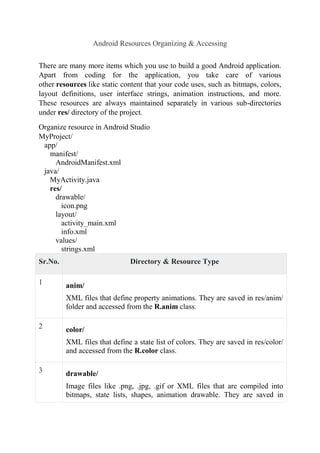
Android Resources.docx
- 1. Android Resources Organizing & Accessing There are many more items which you use to build a good Android application. Apart from coding for the application, you take care of various other resources like static content that your code uses, such as bitmaps, colors, layout definitions, user interface strings, animation instructions, and more. These resources are always maintained separately in various sub-directories under res/ directory of the project. Organize resource in Android Studio MyProject/ app/ manifest/ AndroidManifest.xml java/ MyActivity.java res/ drawable/ icon.png layout/ activity_main.xml info.xml values/ strings.xml Sr.No. Directory & Resource Type 1 anim/ XML files that define property animations. They are saved in res/anim/ folder and accessed from the R.anim class. 2 color/ XML files that define a state list of colors. They are saved in res/color/ and accessed from the R.color class. 3 drawable/ Image files like .png, .jpg, .gif or XML files that are compiled into bitmaps, state lists, shapes, animation drawable. They are saved in
- 2. res/drawable/ and accessed from the R.drawable class. 4 layout/ XML files that define a user interface layout. They are saved in res/layout/ and accessed from the R.layout class. 5 menu/ XML files that define application menus, such as an Options Menu, Context Menu, or Sub Menu. They are saved in res/menu/ and accessed from the R.menu class. 6 raw/ Arbitrary files to save in their raw form. You need to call Resources.openRawResource() with the resource ID, which is R.raw.filename to open such raw files. 7 values/ XML files that contain simple values, such as strings, integers, and colors. For example, here are some filename conventions for resources you can create in this directory − arrays.xml for resource arrays, and accessed from the R.array class. integers.xml for resource integers, and accessed from the R.integer class. bools.xml for resource boolean, and accessed from the R.bool class. colors.xml for color values, and accessed from the R.color class. dimens.xml for dimension values, and accessed from the R.dimen class. strings.xml for string values, and accessed from the R.string class. styles.xml for styles, and accessed from the R.style class. 8 xml/ Arbitrary XML files that can be read at runtime by calling Resources.getXML(). You can save various configuration files
- 3. here which will be used at run time. Alternative Resources Your application should provide alternative resources to support specific device configurations. For example, you should include alternative drawable resources ( i.e.images ) for different screen resolution and alternative string resources for different languages. At runtime, Android detects the current device configuration and loads the appropriate resources for your application. To specify configuration-specific alternatives for a set of resources, follow the following steps − Create a new directory in res/ named in the form <resources_name>- <config_qualifier>. Here resources_name will be any of the resources mentioned in the above table, like layout, drawable etc. The qualifier will specify an individual configuration for which these resources are to be used. You can check official documentation for a complete list of qualifiers for different type of resources. Save the respective alternative resources in this new directory. The resource files must be named exactly the same as the default resource files as shown in the below example, but these files will have content specific to the alternative. For example though image file name will be same but for high resolution screen, its resolution will be high. Below is an example which specifies images for a default screen and alternative images for high resolution screen. MyProject/ app/ manifest/ AndroidManifest.xml java/ MyActivity.java res/ drawable/ icon.png background.png drawable-hdpi/ icon.png background.png layout/ activity_main.xml info.xml values/
- 4. strings.xml Below is another example which specifies layout for a default language and alternative layout for Arabic language. MyProject/ app/ manifest/ AndroidManifest.xml java/ MyActivity.java res/ drawable/ icon.png background.png drawable-hdpi/ icon.png background.png layout/ activity_main.xml info.xml layout-ar/ main.xml values/ strings.xml Accessing Resources During your application development you will need to access defined resources either in your code, or in your layout XML files. Following section explains how to access your resources in both the scenarios − Accessing Resources in Code When your Android application is compiled, a R class gets generated, which contains resource IDs for all the resources available in your res/ directory. You can use R class to access that resource using sub-directory and resource name or directly resource ID. Example To access res/drawable/myimage.png and set an ImageView you will use following code − ImageView imageView = (ImageView) findViewById(R.id.myimageview); imageView.setImageResource(R.drawable.myimage);
- 5. Here first line of the code make use of R.id.myimageview to get ImageView defined with id myimageview in a Layout file. Second line of code makes use of R.drawable.myimage to get an image with name myimage available in drawable sub-directory under /res. Example Consider next example where res/values/strings.xml has following definition − <?xml version="1.0" encoding="utf-8"?> <resources> <string name="hello">Hello, World!</string> </resources> Now you can set the text on a TextView object with ID msg using a resource ID as follows − TextView msgTextView = (TextView) findViewById(R.id.msg); msgTextView.setText(R.string.hello); Example Consider a layout res/layout/activity_main.xml with the following definition − <?xml version="1.0" encoding="utf-8"?> <LinearLayout xmlns:android="http://schemas.android.com/apk/res/android" android:layout_width="fill_parent" android:layout_height="fill_parent" android:orientation="vertical" > <TextView android:id="@+id/text" android:layout_width="wrap_content" android:layout_height="wrap_content" android:text="Hello, I am a TextView" /> <Button android:id="@+id/button" android:layout_width="wrap_content" android:layout_height="wrap_content" android:text="Hello, I am a Button" /> </LinearLayout> This application code will load this layout for an Activity, in the onCreate() method as follows − public void onCreate(Bundle savedInstanceState) { super.onCreate(savedInstanceState); setContentView(R.layout.activity_main);
- 6. } Accessing Resources in XML Consider the following resource XML res/values/strings.xml file that includes a color resource and a string resource − <?xml version="1.0" encoding="utf-8"?> <resources> <color name="opaque_red">#f00</color> <string name="hello">Hello!</string> </resources> Now you can use these resources in the following layout file to set the text color and text string as follows − <?xml version="1.0" encoding="utf-8"?> <EditText xmlns:android="http://schemas.android.com/apk/res/android" android:layout_width="fill_parent" android:layout_height="fill_parent" android:textColor="@color/opaque_red" android:text="@string/hello" />